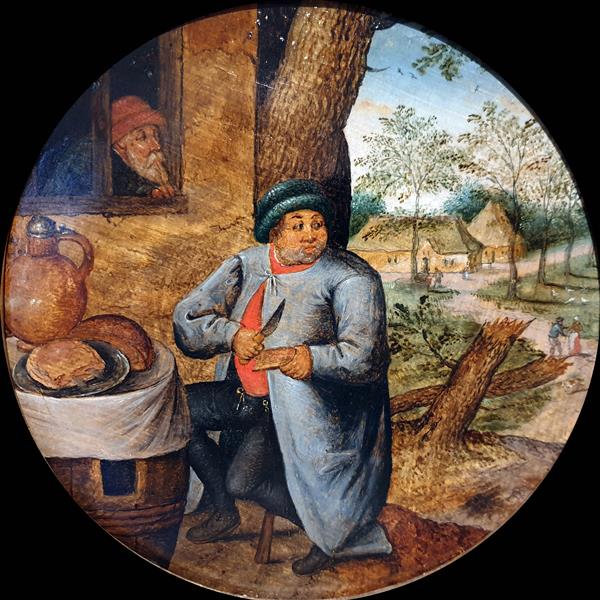Description
Pieter Brueghel the Younger's 1616 painting The Eater of Bread is a vivid manifestation of human complexity caught in a moment of simple everyday activity. Essentially a scene from peasant life, this painting encapsulates not just an act of eating, but a deeper exploration of the emotions, gluttony, and no doubt the religion that permeated the values of the time of its creation.
The compositional approach of the work is intriguing. Brueghel, known for his keen observation of human nature, places a man at the centre of the scene who appears to be literally devouring a piece of bread. His upright posture and exaggerated gestures add a sense of urgency and almost unbridledness to the action he is carrying out, evoking the theme of gluttony, one of the classic capital sins. Surrounding him are other characters who, although less prominent, contribute to an atmosphere of community and at the same time of competition for resources, a mirage of the struggle for sustenance that characterised life in the 17th century.
The colour palette employed by Brueghel the Younger is both rich and subtle, using earthy tones that reflect humble farming life. The predominance of brown and ochre tones not only establishes a direct connection with the land and work, but also underlines the harshness of daily existence. The handling of light in the painting is remarkable: the golden glow of the bread contrasts with the shadows of the background, which directs the viewer's gaze towards the act of eating.
As the protagonist indulges in the act of devouring his bread, other faces can be discerned in the background, seemingly watching him, creating a sense of judgement. This can be interpreted as a commentary on morality and sin, in line with the concerns of society at the time. Likewise, the implicit tension between the central character and the others allows us to glimpse the complexity of human relationships, where hunger becomes both a physical need and a symbol of insatiable desire.
Although Pieter Brueghel the Younger's The Eater of Bread is less well-known than the works of his father, Pieter Brueghel the Elder, its significance lies in the continuity of the simple yet profound themes that both artists explored: the human condition and the everyday. At a time when art was beginning to diversify beyond the religious, this work delves into the portrayal of civil life, echoing the importance of visual storytelling in social narrative.
In conclusion, "The Eater of Bread" is a work that, through its composition and symbolism, invites us to a broader reflection on the nature of desire and survival. Brueghel the Younger's ability to capture the essence of everyday life, along with his technical mastery, makes this painting a standout piece in the context of 17th century art, linking the observation of peasant life with invaluable social criticism.
KUADROS ©, a famous painting on your wall.
Hand-made oil painting reproductions, with the quality of professional artists and the distinctive seal of KUADROS ©.
Painting reproduction service with satisfaction guarantee. If you are not completely satisfied with the replica of your painting, we will refund 100% of your money.

